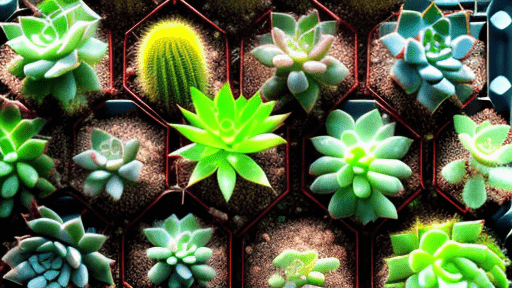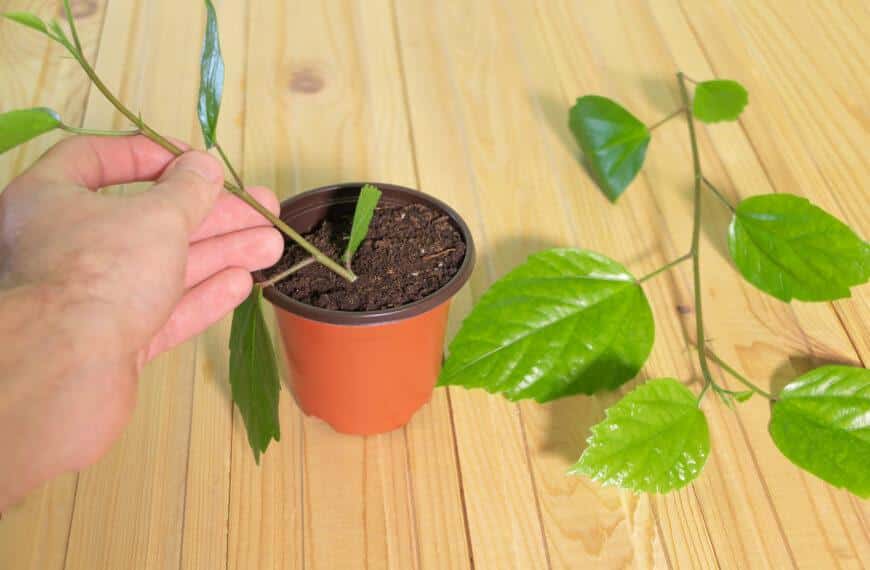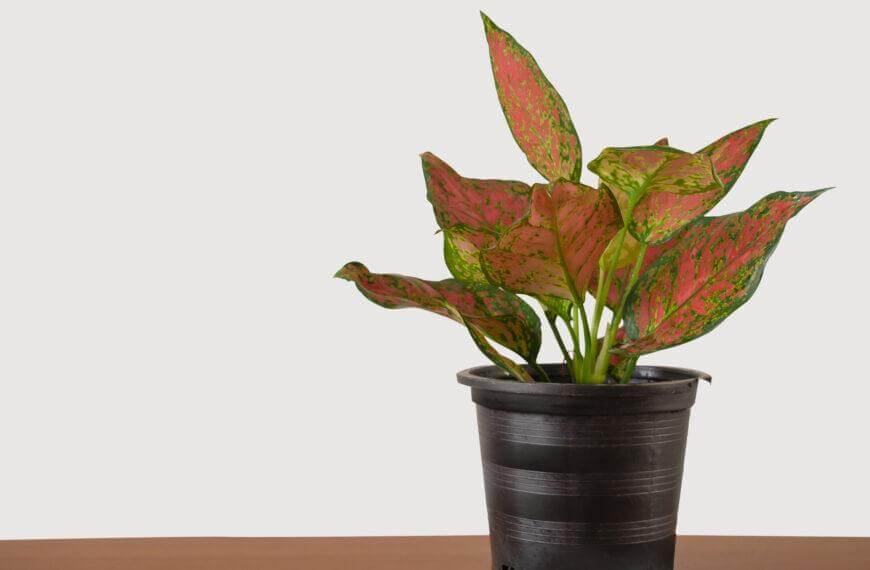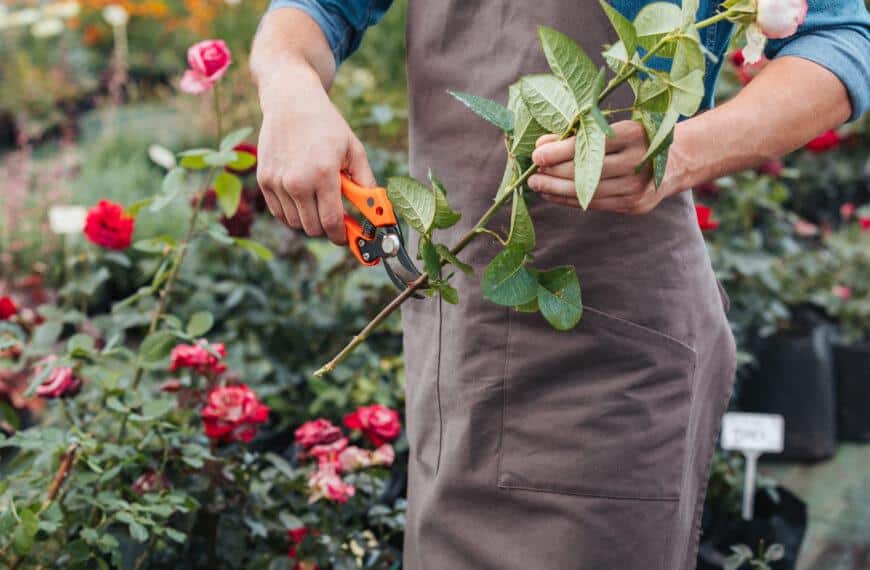Key Takeaways:
- Choosing the right succulents: When selecting succulents, it’s important to consider their light requirements, temperature tolerances, soil needs, and growth habits to ensure they thrive in an indoor environment.
- Proper watering technique: Succulents need infrequent, deep watering to avoid root rot. Always allow the soil to dry out completely between watering, and avoid watering during the dormant season.
- Growing succulents in containers: Plant succulents in pots that are at least 2 inches wider than the root ball to allow room for growth. Use a well-draining cactus mix and add sand or perlite for better drainage. Place the pot in a bright, sunny location and rotate it regularly to ensure even growth.
Do you love indoor plants? Don’t know where to begin? Planting succulents and cacti could be the ideal solution! Bring life to your indoors with ease and confidence. Let’s learn how to do that quickly!
- Key Takeaways:
- Introduction to Succulents in Your Garden
- Choosing the Right Succulents
- Five Trendy Ideas for Using Succulents in the Garden
- Growing Succulents in Containers
- Conclusion and Additional Resources
- Five Facts About How to Plant Succulents and Cacti:
- FAQs about How To Plant Succulents And Cacti: Tips For The Indoor Gardener
Introduction to Succulents in Your Garden
Succulents are a great addition to any garden due to their tough and resilient nature. They originate from desert environments, making them perfect for neglectful gardeners or those who lack a green thumb. Tom Jesch, an expert from Waterwise Botanicals, recommends planting succulents in tough environments like rock gardens, or as work of art on an outdoor wall. Succulents like sedums, sempervivums, and alpine species tolerate high desert heat conditions and mild climates.
To propagate succulents, use their native habitat as a guide. Protect them from extreme temperatures outdoors, especially below-freezing conditions. When growing succulents indoors, it’s important to find the sunniest location, or provide filtered light to avoid blasting sun. Incorporate a well-draining soil mix with materials such as sand, pumice, and small gravel. Overwatering is a top concern, so ensure proper drainage.
Consider incorporating succulents into trendy design ideas like a succulent tapestry, or vertical living walls. Finally, for beautiful luster, use a 15-15-15 fertilizer or a general-purpose houseplant fertilizer for nutrient sources.
Choosing the Right Succulents
What Succulents Are Best Suited for Indoor Planting?
Indoor gardening enthusiasts can beautify their living space with colorful and exotic succulents, but not all types of succulents are suitable for indoor planting. Here are some tips for selecting the right succulent plants for indoor growing.
Choosing the Right Succulents: 6 Points to Consider
- Ideal Environment: Choose succulents that are easily acclimated to dry indoor environments, not those that thrive best in desert environments.
- Reliable Plants: Opt for reliable succulent plants, such as hens and chicks, echeveria, Sahara, agave, moonshine, crassula, ripple jade, hobbit jade, and elephant’s food.
- Novice-Friendly Succulents: If you are new to succulent gardening, choose plants that are easy to care for, such as portulacaria afra, aeonium, and plum petals.
- Amount of Sunlight: Determine the amount of sun your chosen succulents need (two to three hours of sun per day is often sufficient for most succulent varieties) and place them accordingly near an indoor growing window or garden room, or under grow lights.
- Pot Size: Succulents thrive in pots that are one size bigger than the plant’s current pot. Avoid oversizing the containers, as larger containers tend to hold more moisture, which can cause root rot.
- Soil Conditions: Select succulent soil that can absorb water quickly, is well-draining, and does not hold onto too much moisture. Perlite, crushed granite, turface, volcanic sands, and scoria are some common additives used to improve the soil.
Unique Details to Consider When Choosing Succulents for Indoor Gardening
Keep in mind the weather and seasons when growing succulents indoors. During the active growing season, succulents thrive in hotter and drier environments, whereas during the low-light and cool seasons, they may require less water. Some succulent varieties can survive for months without water, and root better in dry soil.
Don’t Miss Out on the Beauty of Succulent Gardening!
Bring the allure of succulent gardening into your living space and take advantage of the trendy, all-purpose design ideas they offer. Experiment with different colors and shapes or try growing vertical gardens with succulent letter gardens using pallet or fence wood. Choose from a variety of decorative stone, organic material, and nonorganic mulch to create your own unique seascape or rocky outcropping. Don’t forget to replant and clean up existing succulent container displays to keep your indoor succulent garden looking fresh and new.
Protecting succulents from extreme temperatures
Succulents are sensitive to extreme temperatures and need proper care to thrive. Providing shade during hot summer days is crucial in protecting their health from scorching heat. Similarly, during winter cold, it’s necessary to protect them from frost bites, which can cause damage to their roots. To protect succulents from extreme temperatures, it’s essential to keep them in a variable environment while maintaining quick-draining soil that enables water retention during periods of drought.
Additionally, correctly pruning unruly shriveled foliage will encourage new growth, allowing succulent varieties such as haworthia, gasteria or Crown of thorns like euphorbia millii and Christmas Cactus.zygocactus in containers to be well-grouped according to their preference; this ensures aesthetic attraction and arranged bask with undersea creatures or natural stone objects for a trendy display idea. Using heavy container arrangements also helps prevent tipping when grown outdoors on a patio or porch.
If you are feeling overwhelmed by figuring out how best to grow succulents at home or indoors using ordinary potting soil mixtures with coarse sand mixture is excellent along with using crushed rock on top layering for decoration purposes but also drainage. Ensuring proper watering practices where succulent types regularly get watered, but the soil isn’t left soggy – it’s especially vital during low-light seasons.
Don’t miss out on the beauty and growing success provided by these easy-to-care-for plants! You may even want to consider adjusting your design template reflecting embroidery patterns featuring curved letters shaped into various types of desert succulents like Echinopsis, Sanseveria among others. Don’t hesitate anymore; use these tips and know-how to get started growing your indoor cacti garden today!
Choosing the right amount of sunlight
For Healthy Succulents, Choose the Appropriate Amount of Sunlight
Succulents are plants that store water in their leaves. They thrive in bright, indirect sunlight and can be grown indoors or outdoors. When choosing the right amount of sunlight for your succulents, it is essential to strike a balance between too much and too little sunshine.
To begin with, assess the light conditions around your home or office. Look for an area that gets at least six hours of indirect sunlight per day. If you don’t have access to these conditions—perhaps due to tall buildings nearby—consider getting grow lights to supplement natural light. East-facing windows are ideal for most succulents, including elephant’s food, while south-facing ones may be too intense.
It is worth noting that different varieties of succulents have distinct lighting requirements. Some types need direct sunlight for several hours a day; others flourish in only partial sun conditions.
For instance, easter lily cactus thrives best under shaded conditions as direct rays from the sun tend to burn their delicate leaves. On the other hand, string succulent such as fishhooks require more sunlight than other varieties.
Ensure that you avoid exposing plants to harsh midday sun and hot afternoon temperatures which can scorch them. To counteract this effect, keep them in a shaded corner during those hours.
Pro Tip: If you expose your succulent plants to excess indoor light without providing enough moisture, they could become poisoned by secondary metabolites production leading to stress or death of the plant.
Watering succulents
Proper hydration for succulents is essential for their growth and survival. Giving them too much or too little water can prove detrimental to their health as they are used to dry conditions.
Here’s a simple guide on how to water your succulents effectively:
- Water your plants only when the soil has dried out completely. The top inch of the soil should be completely dry before watering again.
- When watering, pour water directly into the soil instead of wetting the leaves. This method prevents rotting and insect infestations that may occur if water gets trapped between the leaves for extended periods.
- Ensure that excess water drains from the container, as stagnant water will cause root rot.
- If you notice signs of dehydration, which include wrinkling leaves or brown tips, it’s time to increase watering frequency gradually. Conversely, decrease watering frequency if you notice yellowing or soggy leaves.
It’s important to note that different types of succulents have varying watering needs based on their size, location and growing requirements.
Interestingly, some plants that we commonly call “succulent” aren’t true succulents at all! One such example is Elephant’s food, a trendy houseplant often mistaken for a cactus due to its spiky appearance.
The shipping weight of containers should also be considered when choosing pots for indoor succulents. Always choose lightweight containers that make it easier to move your plants around during landscaping.
Don’t let fear of missing out prevent you from trying out this exciting hobby; with these growing tips coupled with proper care practices like correctly watering using well-draining soil for succulents, planting and pruning techniques tailored per plant variety, you’ll soon have a beautiful indoor garden filled with vibrant succulent life!
Optimal soil and sand mix
To ensure your succulents and cacti thrive, the ideal soil and sand mixture should be tailored to their unique needs. A high-quality, well-draining mix is crucial.
A recommended optimal soil and sand mix for growing succulents and cacti is a blend of 2 parts perlite or coarse sand with 1 part potting soil. This combination promotes proper drainage to prevent root rot while simultaneously providing the necessary nutrients for growth.
Additionally, incorporating ingredients such as worm castings, coconut coir, or pumice stone can provide additional benefits like improved water-holding capacity or better aeration.
When planting your succulents or cacti, be sure to add the soil mixture in levels rather than just dumping it all in at once. Slowly pack in the soil around the plant’s roots for optimal growth.
Don’t miss out on trendy ideas for growing succulents in containers – using unconventional holders can add character and flair to your indoor garden! With proper planting tips and watering schedules, you’ll have happy plants that will thrive in your home.
Planting succulents in pots
Succulent and cacti planting in containers is a simple, yet gratifying method of gardening for indoor enthusiasts. Here are the steps to planting succulents in pots:
- Choose an appropriate container – select a pot that’s appropriately sized for the plant and has sufficient drainage holes.
- Fill with well-draining soil – use a specialized cactus or succulent blend soil mixed with sand to build a suitable substrate.
- Place the plant at the center – carefully place the succulent or cacti at the center of your pot, ensuring that its foliage is above-ground.
- Cover roots and press soil around base – lightly cover roots of your plant with soil mix and gently pat down around its base.
- Water sparingly – give your new addition some water to help moisten the soil mixture but do not overwater as too much moisture can kill a succulent.
Don’t forget each type has unique requirements for placement and orientation; for example, elephant’s food may need slightly more sun exposure than other varieties of plants.
I recall meeting a florist who started her very own cacti farm on her balcony by researching tips online and trialling implementations on her mini pots gradually progressing to larger vessels.
Pruning succulents
Maintaining succulent plants through pruning is crucial for maintaining their health and promoting growth. To help your succulents thrive, it’s essential to know how to trim them properly:
- Remove dead or damaged leaves and stems with clean, sharp scissors.
- Cut back leggy succulents to promote bushier growth by trimming off the top portion of the plant.
- Pinch off new growth at the tips of branches to encourage lateral branching.
- Trim blooms after flowers fade to prevent the plant from putting all its energy into seed production, which will weaken it.
- Cut back sprawling succulents like elephant’s food to keep them compact and aesthetically pleasing.
- Avoid over-pruning, as it may cause damage and susceptibility to disease in your succulent.
In addition to regular pruning, it’s crucial not to overwater your succulents. Watering once a week is enough for most species, but always check if the soil is dry before watering.
Proper pruning techniques not only ensure healthy growth but also contribute to aesthetic appeal by shaping your plants beautifully. Remember to prune your succulents sparingly yet regularly for flourishing indoor gardening experience.
Fertilizing succulents
Nourishing succulent plants is critical to ensure healthy growth. Proper fertilization can enhance the plant’s resilience while also promoting overall health. Here’s a simple guide to help you fertilize your succulents.
- Begin by choosing the right type of fertilizer.
- Use a well-balanced, water-soluble mix for best results.
- Avoid applying too much fertilizer as it can damage roots and result in foliage burn.
- During the plant’s growing season, apply a mild solution every two weeks.
- In winter months, suspend fertilizer applications entirely, or use a reduced formula that’s balanced with phosphorus.
- Water your succulents after fertilizing them.
It is essential to select the right product for your plants to achieve optimal results because each plant has specific requirements. Furthermore, when using this technique, it is recommendable that some succulent species like Elephant’s food do not require regular fertilization and can grow well without any supplements.
A fascinating fact: Plants communicate with one another through their root systems by releasing chemical signals into the soil. Researchers discovered that mature trees share nutrients with seedlings even from other species (source: Live Science).
Five Trendy Ideas for Using Succulents in the Garden
Succulents are becoming increasingly popular among garden enthusiasts. For those looking to incorporate these plants into their outdoor spaces, here are some trendy ideas that are sure to turn heads.
- Use Elephant’s Food and succulents to create a green and colorful carpet in your garden.
- Grow succulent walls or frames that can be used as living art pieces.
- Create a low-maintenance rock garden with a variety of succulents that thrive in rocky environments.
To add a unique touch to your succulent garden, consider planting various types of succulents that have different shapes, textures, and colors. This will create an eye-catching display that is sure to impress. One suggestion is to use different pots and containers to display your succulents.
This not only adds variety to your garden but also allows for easy movement of plants as needed. When planting succulents, it is important to remember not to over-water them. Succulents roots are shallow, and they store water in their leaves, so they can last long periods without needing to be watered.
Incorporating succulents into your garden is a great way to add a unique, low-maintenance touch. With these trendy ideas, you can create a stunning display that is sure to impress.
Growing Succulents in Containers
Succulent Houseplants in Containers for Indoor Gardening
Growing succulents in containers is a great way to bring nature indoors and add a touch of green to your home decor. Here’s a simple 3-step guide to get you started:
- Choose the Right Container: Succulents require plenty of drainage, so make sure to choose a container with drainage holes. Also, ensure the container is appropriate for the size of your succulent.
- Plant the Succulent: Fill the container with a well-draining soil mixture and gently place the succulent on top. Firmly pack the soil around the roots and water the plant thoroughly.
- Proper Care: Succulents need minimal watering, so be careful not to overwater them. Keep them in a bright spot with indirect sunlight and rotate them occasionally.
Additionally, you can add some “elephant’s food” to your container garden for an interesting texture variation.
Don’t miss out on the benefits of growing succulents in containers. They are easy to care for and bring a unique charm to any indoor space. Start your own succulent container garden today!
Conclusion and Additional Resources
Succulent and cacti indoor gardening is an easy and rewarding hobby, requiring minimal maintenance and adding beauty and interest to your home.
When it comes to concluding and finding additional resources for your succulent and cacti journey, there are some helpful tips to keep in mind. Understanding the unique needs of each specific succulent or cacti you have can be aided by referring to specific plant guides and care charts. Additionally, joining online communities and forums can provide useful advice and support for any questions that may arise.
Taking care of succulents and cacti requires special attention to the amount and frequency of watering, location of plant placement, and proper soil mixtures. It is essential to ensure the soil is well-draining to prevent root rot and overwatering, and to find the right balance of sunlight exposure. Understanding the particular needs of each plant can help ensure healthy growth and longevity.
Elephant’s food, for example, is a popular succulent that requires good drainage and moderate watering. In contrast, a cacti such as the Christmas cactus prefers higher humidity levels and more frequent watering. By paying attention to the specific requirements of your plants, they can thrive and bring joy into your home for years to come.
Planting and caring for succulents and cacti can have added benefits beyond just decoration, such as improving mood, reducing stress, and even purifying the air. Making small changes in your gardening practices can have a big impact on the health and beauty of your indoor plants and ultimately your well-being.
Five Facts About How to Plant Succulents and Cacti:
- ✅ Succulents and cacti prefer well-draining soil and pots with drainage holes. (Source: The Spruce)
- ✅ These plants do best in bright, indirect light, and should not be exposed to full sun for long periods of time. (Source: Better Homes & Gardens)
- ✅ Overwatering is a common mistake with succulents and cacti, as they can rot if their soil is too wet. (Source: Gardening Know How)
- ✅ Propagating succulents and cacti is relatively easy, and can be done through stem cuttings or leaf cuttings in some cases. (Source: HGTV)
- ✅ There are a wide variety of succulent and cactus species available, each with its own unique care requirements and aesthetic qualities. (Source: The Old Farmer’s Almanac)
FAQs about How To Plant Succulents And Cacti: Tips For The Indoor Gardener
What is Elephant’s Food?
Elephant’s Food is a type of succulent plant that grows well inside the house. It has green, fleshy leaves and produces a white flower when it blooms. This plant is native to Mexico and can effectively store water in its leaves and stem, making it perfect for the arid environment.
How to Plant Succulents?
Planting succulents and cacti is easy. Start by selecting a planter with a drainage hole in the bottom. Use a mixture of potting soil and sand to fill the container. Make sure the soil is well-draining and not too compact. Add your succulent or cactus and lightly pack the soil around its base. Water the plant sparingly, being careful not to over-water your succulent.
What is the Best Way to Grow Succulents?
The best way to grow succulents is to provide them with bright, direct sunlight, but they can also survive in indirect light. Make sure to water the plant only when the soil is dry and provide good drainage. Always use a well-draining soil mixture and plant in a container with a drainage hole.
How to Water Succulents?
Watering succulents can be tricky. They prefer a dry environment, so it’s best to water them only once the soil is dry. Over-watering can cause the roots to rot and the plant to die. When you do water your succulent, make sure to do it thoroughly, penetrating the soil to the bottom of the container. Don’t let water sit in the container or leaves.
Can You Have Succulents and Cacti Together in One Container?
Yes, you can plant succulents and cacti together in one container. These two types of plants share similar care requirements and complement each other’s beauty. Just make sure that the pot is large enough to accommodate both plants and they both get the amount of light they need.
What are Some Tips for Indoor Succulent Gardening?
Some tips for indoor succulent gardening are to choose containers with drainage holes, provide good drainage soil, and use a potting mix specially formulated for succulents. Place them in a bright, sunny location or under grow lights. Water sparingly during winter, fertilize only during spring and summer, and prune as needed.




